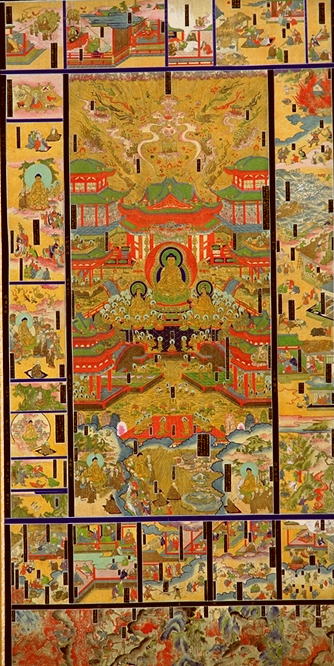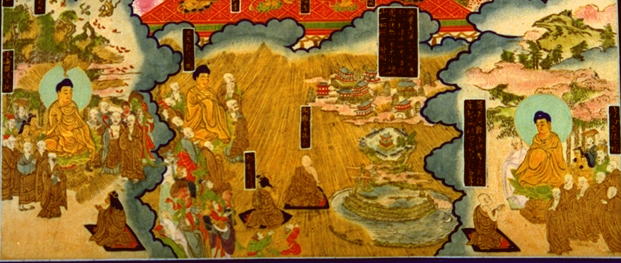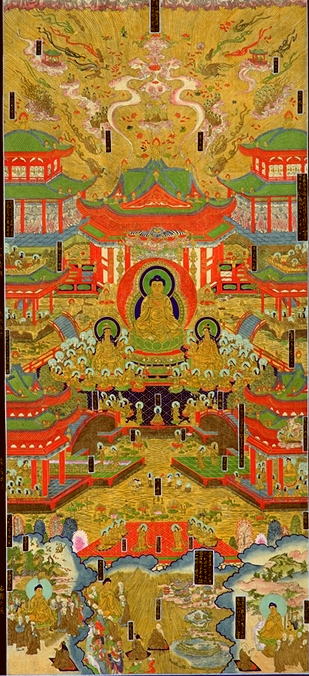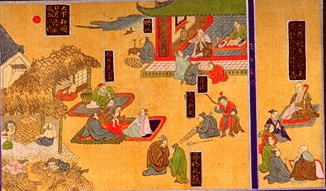THE LARGER SUTRA MANDALA
Back to Index
[Whole picture]

Jump to: Chart, [A],
[B],
[C], [D], [E], [F],
[G], [H]
Back to Index
INTRODUCTION
Compared with the Taima Mandala, very little
has been known about the Larger
Sutra Mandala. The original painting, modelled
on the Taima Mandala, was
presumably made in the middle of the Edo
period, i.e., the 18th century.
Then its wood-block prints were produced
and distributed in limited circulation.
Those prints were painted in yellow-gold
and brilliant colors, and explanatory
notes painted in gold on strips of black
paper were pasted on the relevant
scenes of the mandala.
[Chart]
Click Roman letters to jump to the explanation
below
[D] Birth of the three grades
of aspirants
1. Upper, 2. Middle, 3. Lower
(ch.23-25)
________________________________________________________________________ |
|
[E] Shakyamuni's encouragement
of virtuous acts
(ch. 40)
________________________________________________________ |
[B] Dharmakara's
vows and
practice
7 Supreme fruition
of his meritorious
acts (ch. 9)
6 Performance of
the bodhisattva
practice (ch. 9)
5 Proclamation of
the vows (ch. 9)
4 Contemplation
for five kalpas
(ch. 6)
3 Many Buddha-lands
shown by the Buddha
Lokeshvararaja (ch. 6)
2 Renunciation of
the world (ch. 5)
1 This sutra will
remain long in the
world
(ch.47)
|
[C] Glorious manifestations of the Pure Land
20 Sky (ch. 20)
19 Arrivals and departures of bodhisattvas
(ch. 28, 42, 46)
18 Transformation of light (ch. 21)
16-17 Jewelled pavilions (ch. 21)
15 Bodhi-tree (ch. 15)
13-14 Ponds, trees and flowers (ch. 16)
11-12 Pavilions for those born in the Pure Land
(ch. 17)
9-10 Lecture halls (ch. 29)
8 Amida, Avalokiteshvara and Mahasthamaprapta
(ch. 11, 28)
7 Visiting bodhisattvas and those born in the Pure
Land (ch. 23, 26)
5-6 Jewelled ground (ch. 20, 21)
4 Jewelled pond (ch. 16)
2-3 Jewelled trees (ch. 14)
1 Dance and music (ch. 10, 27)
----------------------------------------
[A] Teaching of the Larger Sutra
3 2 1
Transmission Illumination of the Beginning
of the sutra whole world with of the
to Maitreya Amida's light sutra -
Vulture Peak
(ch. 47) (ch. 41) (ch. 3) |
[F]
Admonition
against three
evil acts
(ch. 31)
|
|
[G] Give great evils and their painful
retributions (ch. 35-39) |
|
(3) Eight great hot hells
_________________________________________ |
[H] Immeasurable pain in the three evil
realms (ch. 35-40)
______________________________________________________________________ |
(2) (1)
___________________ |
8.
Avici
_______ |
7.
Great
Scorching
_____________ |
6.
Great
Shrieking
_____________ |
5.
Scorch-
ing
____________ |
4.
Shriek-
ing
__________ |
3.
Crushing
Mountains
_______________ |
2.
Black
Rope
__________ |
1.
Reviv-
ing
___________ |
Realm of
hungry
spirits
_______________ |
Realm
of
animals
______________ |
GENERAL COMPOSITION
The Larger Sutra Mandala in the late Mr.
Stewart's collection and now in
the possession of the Pure Land Mandala Study
Group has eight sections,
showing prominent features described or referred
to in the sutra.
The above chart shows the eight sections
in Roman letters, from [A] to
[H], and the chapter references given in
brackets will help the reader
to refer to the text of the Larger Sutra. This chapter division
is the same as that in H. Inagaki's translation of the
sutra and also agrees with that in the Honganji
edition of the original
Chinese text and its Japanese transcription
published by Honganji in 1988
with the title, "Jodoshinshu Seiten".
[A] Teaching of the Larger Sutra
Click links for larger images
 |
In this panel we
read from right to left. The scene on the
right [1] shows Buddha Shakyamuni
sitting on the lotus-throne. Surrounded by
the audience and facing a monk,
who is Ananda, the Buddha is about to begin
his delivery of the sutra.
The place is Vulture Peak near Rajagriha. According
to the sutra, the number of the monks is
12,000 and also present are all
the bodhisattvas in this cosmic period, called
Bhadra Kalpa (Auspicious
Aeon), including sixteen lay-bodhisattvas
headed by Bhadrapala. If you
have a close look at the scene, you can see
Bhadrapala in white robe on
the left-hand side of the Buddha. The next
scene in the center [2] shows
the manifestation of the Pure Land. Toward
the end of the sutra, Amida
emits a great flood of light, which illumines all
the worlds including Mt. Sumeru and reveals various
Buddha-lands. Mt.
Sumeru is located at the center of the world-unit;
it is surrounded by eight mountain-ranges,
and in the ocean between the 7th and the
8th there are four continents inhabited by
humans. On the top of Mt. Sumeru is a palace,
which is a heavenly palace of Trayastrimsha
(Heaven of Thirty-three Gods) ruled by Shakra
(the lord of gods). Above this in the clouds,
many towers and storied buildings are
seen, which indicate Buddha-lands. In the
flood of light the audience envision Amida
and his Pure Land. Ananda with his right
shoulder bared faces towards Amida and worships
him. Behind him sits a long-haired monk,
who is Maitreya, the future Buddha. On his
left sits Buddha Shakyamuni surrounded by
monks, bodhisattvas and deities. A layman
and laywoman are seen behind Maitreya worshiping
Amida. The next scene on the left [3] is
the end of the sutra. The
Buddha entrusts Maitreya, who sits in the foreground facing him,
with
transmission of the sutra in the future.
The Buddha is surrounded by the
audience; above him in the sky hovers a heavenly
lady; also musical instruments
and flowers shower from heaven.
Back to Chart; back
to the whole picture
[B] Dharmakara's vows and practice
 |
The panel [B] has seven frames. The bottom
one [1] shows the period of
extinction of the Dharma which comes after
this period of Decadent Dharma
(mappo), i.e., about 10,000 years from now.
The Larger Sutra states
that even when all the other Buddhist teachings
perish this
sutra will survive for a hundred more years to bring people to emancipation.
In the period of no Dharma people have very
little stock of merit and are
spiritually starving. Ominously, two people
depicted here are naked; with
emaciated appearance and a swollen belly,
they are physically starving,
too. Have you not seen a picture like this
in a film of the nuclear holocaust?
The title of the Larger Sutra is seen on the rocky hill, and the
two people are worshipping it as the final
refuge. Above this, and from
the second to the top frame, are the scenes
of Amida in his bodhisattvahood.
First [2], the king who later became Amida renounces
the world; he throws away his royal costume and shaves
his head. A
sorrowful minister respectfully receives
the costume. Two attendants by
a horse are crying. Next [3], the king becomes
a monk under Lokeshvararaja
Buddha, who sits on the lotus-throne, and
is named Dharmakara. At his request,
the Buddha shows him 21 billion Buddha-lands,
which are partly depicted in the circle.
This vision gives Dharmakara an
idea of the Pure Land that he is going to
establish. Above this [4] is
a scene of Dharmakara's retreat in the mountain, where he contemplates for five kalpas.
The next frame [5] is Dharmakara's
proclamation of the vows before Lokeshvararaja and all beings. (Open
48-vows for reference) Monks are seen in front and devas and demigods
are on the side and in the background. In
the sky are flying heavenly ladies, flowers
and musical instruments, which indicates
that the whole world is praising Dharmakara's
vows. The sutra says, "...the entire
earth shook in six ways, and a rain of wonderful
flowers fell from heaven, scattering everywhere.
Spontaneous music was heard, and a voice
in the sky said, 'You are sure to attain
the highest, perfect Enlightenment.'"
The next frame [6] shows that cultivation
of merits in Dharmakara's practice as a bodhisattva
lasts for many aeons, during which he is
reborn as a rich man, a ksatriya king, a
cakravartin, a Brahma-king, and so on. Five of his reincarnations
in those states are shown here. While reborn
as such, he performs
puja to Buddhas. Above the Buddha's head is a scene of Dharmakara
expounding the Dharma to other people and urging them to perform the
Six Paramitas. The last frame of this panel
[7] shows that Dharmakara has
nearly accomplished the bodhisattva practices.
He
has amassed enormous merits, with which he is able to produce from
his hands various treasures, clothes, food
and drink, flowers, banners
and other ornaments.
Back to Chart; back to the whole picture
[C]
Glorious Manifestations of the Pure Land
 |
The dominant features in the mandala are
in the central
panel. In the center of this panel, Amida
sits on a glorious lotus-throne and his hands
are in the mudra
of Dharmacakra- pravartana (mudra of turning the Wheel of Dharma) [8].
This is the same mudra as that of Amida in
the Taima Mandala. This mudra
is also seen in the mural painting of Amida at
Horyuji and can be traced back to the 5th-century
statue of Shakyamuni
preserved at Sarnath Museum. Amida's body
radiates a brilliant halo, and
a beautiful canopy hangs over his head. A
magnificent roof dominates the
scene; it houses the Bodhi-tree, which is partly seen behind the four pillars
[15]. The space between this hall and the
storied buildings on the right and left
[13,14] is filled with water where lotus-flowers bloom, and on the banks sandalwoods grow. Amida is attended by two bodhisattvas, Avalokiteshvara
(Kannon) on his left and Mahasthamaprapta (Seishi)
on his right [8], each of them surrounded
by many bodhisattvas. In the
hall in front of the three sages sits a newly born
devotee who is in the higher grade;bodhisattvas
from other worlds are also seated in the hall [7]. On the
lotus-seats
below in the pond sit two other devotees
who are in the middle and lower
grades; some of them are venerating Amida,
and others are welcoming the
newly born. Further down in the pond [4] six newly
born are enjoying a bath. The water rises
and recedes as one wishes. Above
them two rectangular terraces [5,6] stick
out in the pond; they are the
jeweled ground. When one steps on it, the earth sinks four
inches;
when one lifts one's foot, the earth rises
to the former level. On the
left-hand side, colorful cloth is spread
on the ground as a carpet. There
is a stage in the foreground [1], where music
is played and dance is performed. This is
taken as a kind of offering to
the Buddha and expression of gratitude to
him. To the right and left of
the dance-stage [2,3], there are jeweled trees.
There are majestic buildings on either side
of the panel. In the lower
building on the right, which is a lecture-hall
[9], a Nirmanakaya Buddha (apparitional Buddha)
is preaching the Dharma,
and in the similar building on the left [10]
a bodhisattva is giving a
sermon. In the buildings on nearly the same level
as the three sages [11,12] people are enjoying pleasures. The
buildings on the highest level are also the abode of those born in
the Pure Land [16,17]; in those buildings
are seen various ornaments and
banners hanging from the ceiling. Above the
roofs of the buildings spreads
the sky full of glorious objects spreads.
A phantom
formation of light in the center dominates the scene [18],
in which
transformed bodies of the Buddha and his
two attendant bodhisattvas are
manifested. The light transforms itself into
clusters of brilliant clouds
and lotus-flowers. Many Buddhas are seen
just outside the fringe of the
light formation; they are transformed Buddhas
produced from each lotus-flower.
Throughout the sky, kalavinkas and other
birds fly, heavenly maidens make
offerings, musical instruments hover, and
mandarava flowers are scattered
in profusion. Among them are seen endless
comings
and goings of bodhisattvas [19], some visiting the Pure Land from other
worlds and others going to visit other Buddha-lands.
On the uppermost fringe
of the sky hangs a jeweled net [20], which
serves as rich decoration.
Back to Chart;
back to the whole picture
[D] Birth of the Three Grades of Aspirants
The first three frames from the left-hand
corner of the upper panel show
the three grades of aspirants. The higher grade
of aspirants on the left [1] are monks who devote themselves
to the
Pure Land practices; when they die, Amida
comes to them with holy sages
to take them to the Pure Land. The middle
frame shows the
middle grade of aspirants [2], who do not renounce the world but diligently
practice the Pure Land Way; they build stupas,
give alms to monks, and
make offerings to the Buddha. When they die,
they see transformed bodies
of Amida and holy sages welcoming them. The
next frame is the
lower grade of aspirants [3]. Though unable to do many deeds of merit,
they awaken aspiration for Bodhi and single-mindedly
concentrate on Amida
even ten times. When they die, they see Amida
in a dream, and thus attain
birth in the Pure Land.
Back to Chart
[E] Shakyamuni's Encouragement of Virtuous
Acts
The two frames on the right side of the top
panel show that a teacher urges
people to practice the Way diligently [1]
and that under the influence
of the Buddha's virtue, people do virtuous deeds and
so enjoy peaceful life [2].
Back to Chart;
back to the whole picture
[F] Admonition against Three Kinds of
Evil Acts
The long panel on the
right side is descriptive of various evil
deeds which we do through greed,
anger and stupidity. The details of all kinds
of evil deeds are presented
in the sutra, of which good examples are
shown here in realistic pictures.
Also depicted here are sufferings caused
by fire and floods. Death which
comes to everybody is shown at the bottom
in the form of cremating fire
and digging of the ground for burial. The upper and
middle parts are shown in large images.
Back to Chart;
back to the whole picture
[G] The Five Great Evils and their Painful
Retributions
The panel above the bottom shows from right
to left the five evils which
bring about painful retributions. The first
frame depicts killings and
their karmic retributions [1]. The second
is a scene of unlawful and criminal
acts [2]. The third depicts immoral acts, theft,
and fightings [3]. The fourth describes evil
acts done with the mouth [4]. The last frame in the left is a scene
of wanton acts and disbelief of the Buddha-Dharma.
Back to Chart;
back to the whole picture
[H] Immeasurable Pain in the Three Evil
Paths
The bottom panel shows painful retributions
of evil acts. In the right
is the realm of animals; one can see animals
and birds fighting each other for survival
[1]. Next, below it in the corner
is the realm of hungry spirits, who suffer from
hunger and thirst [2]; as soon as they want
to drink water, it turns into
flames. The eight scorching hells are depicted
in the most realistic touch
[3]. First, the hell of "All Reviving"
(1), where sinners undergo interminable pain;
when they die, the guard
revives them and forces them to receive further
pain. Second, the hell
of "Black Rope" (2), where sinners are forced to walk on
the red-hot iron ropes; when they fall off,
a great mass of fire burns
them. Also, a red-hot iron rope is tied around
the sinner and the guard
cuts the body along the rope. Third, the
hell of
"Crushing Mountains" (3), where sinners are hung upside down,
crushed with a rock, or are chasing after
women only to be cut by the sharp
edges of the leaves. Fourth, the hell of "Shrieking"
(4), where sinners are driven into flames,
or red-hot iron bars are forced
into their mouths, or their intestines are
pulled out. Fifth, the hell
of "Scorching" (5), where sinners are fried in huge flames.
Sixth, the hell of "Great Shrieking"
(6), where sinners are tied to stakes and
the guards pull out their tongues
with red-hot iron pincers. Seventh, the hell of "Great
Scorching" (7), where sinners are burnt alive in a
huge mass of
fire. Eighth, the hell of "Uninterrupted Torment"
(Avici) (8), where big dogs, pythons and monsters
with many heads vomit
volumes of flame to burn the sinners. In
the Larger Sutra there
is no description of hell, but the artist
depicted it based on Genshin's
Ojoyoshu.
Back to Chart
[Postscript] The Larger Sutra Mandala
is a valuable visual aid to the understanding
of the Larger Sutra.
The Chinese translation of this sutra is
a difficult text to read for all
nationalities, but its message is easily
understood through this mandala.
The name of the artist is not known, but
the mandala was no doubt composed
under the guidance of a scholarly priest
belonging to the Jodo or Jodoshinshu
school. We can also derive from this mandala
many spiritual messages. It
shows Amida's Dharma in action and our karma
with painful retributions.
[Bibliography]
H. Inagaki, The Three Pure Land Sutras: A study
and translation, Nagata Bunshodo, 1994; third edition, 2000, pp. 225-313..
H. Inagaki, The Three Pure Land Sutras, BDK English Tripitaka 12-II, III, IV, Numata Center for Buddhist Translation
and Research, 1995, pp. 19-89; second edition, 2003, pp. 1-71.
Link to: Pure Land
Mandala Study Group
 Return to Mandala-Index; Index
Return to Mandala-Index; Index










![]() Return to Mandala-Index; Index
Return to Mandala-Index; Index